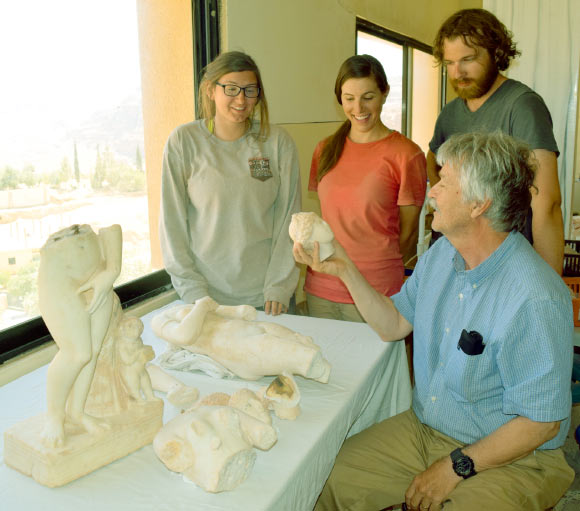A team of archaeologists from North Carolina State University and East Carolina University has discovered two marble statues of Aphrodite, the Greco-Roman goddess of love, in the ancient Nabataean city of Petra in Jordan.

Prof. Parker, sitting far right, and students examine a statue of Aphrodite, discovered during a 2016 excavation in Petra, Jordan. Image credit: Tom Parker.
“Our team found the pieces while excavating domestic structures in Petra’s North Ridge area during May and June,” said dig co-director Tom Parker, a professor of history at North Carolina State University.
The marble statues, which also feature the mythological god Cupid, are largely intact from pedestal to shoulders.
Both statue heads and much of their upper extremities were also recovered at the site.
The statues are Roman in style, which provide additional insight to the cultural impact of Rome’s annexation of Nabataea in 106 CE.
“The Nabataeans were true geniuses in many ways, in part because they were ready and willing to assimilate to and adopt elements of other cultures around them,” Prof. Parker said.
“They adopted a lot of Egyptian culture when they were neighbors. When Romans took over, they were open to Roman influence.”
While the marble statues are remarkable finds, they’re also somewhat unexpected.
The archaeologists were digging what they thought was an ordinary home when they came across something much more.
“The house was more like an urban villa equipped with its own sophisticated bath house,” Prof. Parker said.
“Our team found the fragmented statues next to the home’s staircase.”
Prof. Parker and his team found a wealth of other artifacts that shed more light on Nabataean daily life.
Digging one other domestic structure and three rock-cut shaft tombs, they discovered installations for cooking and storage, occupational remains such as pottery and animal bones, an iron sword, ceramic oil lamps and human bones intermixed with personal adornments and jewelry.







